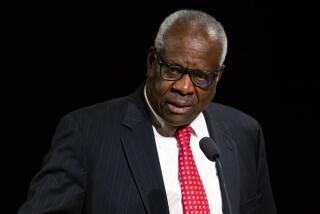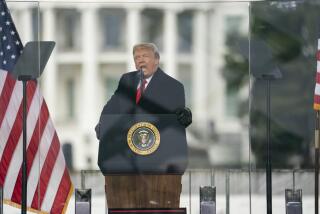Book review: âTangled Websâ by James B. Stewart
For a nation whose romanticized history includes a young George Washington confessing to chopping down a cherry tree because he âcannot tell a lie,â we seem to do an awful lot of lying. But then, the story about Washington is a lie itself, so maybe weâre just being true to our national character.
In his new book, âTangled Webs,â Pulitzer Prize-winning journalist James B. Stewart dives deeply into four recent cases of high-profile conspiracies of lies. What he finds does not say good things about us.
Starting with former presidential advisor Karl Rove, Stewart argues that quite often presumably honorable people do dishonorable things. The reasons are myriad, but there are common threads. A sense of hubris that no one will find out. Fear of exposure of a misdeed. Calculated risk. Greed or misplaced loyalty.
The repercussions can be severe, particularly in a legal system predicated upon the belief that people under oath will tell the truth. Stewart argues convincingly that an oath to âtell the truth, the whole truth and nothing but the truthâ is as solid as the air into which it is spoken, primarily because perjury prosecutions are rare. So rare, in fact, that for those who live under a code of cost-benefit analysis, lying under oath can be a better gamble than telling the truth.
âWe appear to be on the brink of becoming a society where perjury is the norm,â Stewart writes. âWe lionize those who win, and turn a blind eye to cheating.⌠The consequences are devastating.â
Stewartâs book is built around four scandals that came to light in the 2000s: the Martha Stewart insider-trading case; I. Lewis âScooterâ Libby, who was at the center of the George W. Bush administration scandal in which Valerie Plame was outed as a covert CIA agent; baseball star Barry Bonds and his response to suspicions that he had used performance-enhancing drugs; and Ponzi master Bernie Madoff.
It is an exhaustive â and exhausting â bit of reporting, and narrative writing. In fact, the biggest weakness of the book is the depth of detail. Each scandal gets its own section, and you almost need a chart to keep track of who is who, particularly in the more obscure lower tiers of the scandals. Conversely, Stewartâs concluding analyses about the cases are short. In the end, you wish for less arcane detail (which includes long conversations) and more analysis. As it is, the book feels more like a lawyer building a case than a journalist telling a story.
But they are intriguing cases, led by Stewartâs dissection of the episode involving Plame, whose identity as a CIA undercover agent was leaked to journalists by top White House officials after her diplomat husband, Joseph Wilson, was critical of White House policies in Iraq.
Stewart points out that FBI investigators believed White House senior advisor Rove and Richard Armitage, a deputy secretary of state, had both lied during the investigation. And Vice President Dick Cheney, Libbyâs boss, exhibited a remarkable lack of recollection of potentially criminal conversations in which he was involved.
Though investigators didnât think they could convict Rove and Armitage, the two menâs falsehoods were clear, Stewart says. Yet President Bush took no action, despite earlier pledges to punish whoever was behind the leak. Libby, the main focus of the investigation, ultimately was convicted of perjury and obstruction of justice, but Bush commuted his sentence. âThe message seemed inescapable,â Stewart writes, âthat in the Bush White House, loyalty trumped truth.â In the end, the only person jailed was one of the reporters to whom Plameâs identity was leaked â the New York Timesâ Judith Miller, for refusing to name her source.
After all that, Stewart sums up, âThe charges against Libby did show a dispiriting willingness to lie â repeatedly and under oath â at the highest levels of the government. If Libby had lied about Plame, who else in the White House lied, and about what?â About what, indeed.
Stewart gives equal attention to the Martha Stewart insider-trading scandal, the lies at the heart of the Bonds case (he was ultimately convicted only on an obstruction of justice charge), and the half-truths and misdirections surrounding Madoffâs scam.
The repercussions of lies from top White House officials are more serious than those of a baseball star or a celebrity CEO. In Madoffâs case, of course, thousands of investors lost tens of billions of dollars, and the pain of his mendacity spread far and wide.
But ultimately, Stewartâs book is less about his voluminous details than it is about the pervasiveness of lies, and, to borrow an Al Franken phrase, the lying liars who tell them, from sports to Wall Street to the White House.
Scott Martelle, an Irvine-based writer, is the author of âThe Fear Within: Spies, Commies, and American Democracy on Trialâ (Rutgers).
More to Read
Sign up for our Book Club newsletter
Get the latest news, events and more from the Los Angeles Times Book Club, and help us get L.A. reading and talking.
You may occasionally receive promotional content from the Los Angeles Times.








